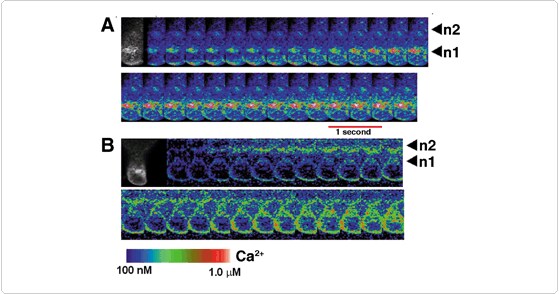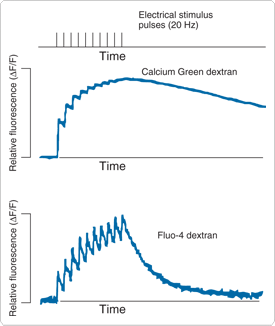Search
Page Contents
Related Tables
Related Technical Notes
Get Chapter Downloads from The Molecular Probes Handbook, 11th edition |
When ion indicators are loaded into cells as their acetoxymethyl (AM) esters, they may translocate to intracellular compartments, where they are still fluorescent but no longer respond to changes in cytosolic ion levels.![]() This problem frequently limits the experiment's duration because sequestration of the indicator into organelles will cause errors in the estimated cytosolic ion levels. Furthermore, Ca2+ indicators such as fura-2 and indo-1 may bind to cellular proteins,
This problem frequently limits the experiment's duration because sequestration of the indicator into organelles will cause errors in the estimated cytosolic ion levels. Furthermore, Ca2+ indicators such as fura-2 and indo-1 may bind to cellular proteins,![]() which can markedly alter the indicator's response to Ca2+ (Comparison of in vitro and in situ Kd values for various Ca2+ indicators—Table 19.2).
which can markedly alter the indicator's response to Ca2+ (Comparison of in vitro and in situ Kd values for various Ca2+ indicators—Table 19.2).
To overcome these limitations, we have prepared dextran conjugates of some Molecular Probes ion indicators ![]() (Summary of Molecular Probes fluorescent Ca2+ indicators—Table 19.1). Dextrans are hydrophilic polysaccharides characterized by their moderate to high molecular weight, good water solubility and low toxicity. They are also biologically inert due to their uncommon poly-(α-D-1,6-glucose) linkages, which render them resistant to cleavage by most endogenous cellular glycosidases. Indicator dextrans must be loaded into cells by microinjection, whole-cell patch clamping, microprojectile bombardment
(Summary of Molecular Probes fluorescent Ca2+ indicators—Table 19.1). Dextrans are hydrophilic polysaccharides characterized by their moderate to high molecular weight, good water solubility and low toxicity. They are also biologically inert due to their uncommon poly-(α-D-1,6-glucose) linkages, which render them resistant to cleavage by most endogenous cellular glycosidases. Indicator dextrans must be loaded into cells by microinjection, whole-cell patch clamping, microprojectile bombardment ![]() or electroporation,
or electroporation,![]() or by using our Influx pinocytic cell-loading reagent (I14402, Chelators, Calibration Buffers, Ionophores and Cell-Loading Reagents—Section 19.8;
or by using our Influx pinocytic cell-loading reagent (I14402, Chelators, Calibration Buffers, Ionophores and Cell-Loading Reagents—Section 19.8; ![]() ). Calcium indicator dextrans are actively transported in adult nerve fibers over a significant distance and are retained in presynaptic terminals in a form that allows monitoring of presynaptic Ca2+ levels.
). Calcium indicator dextrans are actively transported in adult nerve fibers over a significant distance and are retained in presynaptic terminals in a form that allows monitoring of presynaptic Ca2+ levels.![]() Dextran conjugates above ~2000 MW are well retained in viable cells, will not readily pass through gap junctions
Dextran conjugates above ~2000 MW are well retained in viable cells, will not readily pass through gap junctions ![]() and are less likely to become compartmentalized.
and are less likely to become compartmentalized.![]() Also, fluorescence photobleaching measurements have shown that, as compared with low molecular weight dyes, dextran conjugates are much less likely to bind to proteins.
Also, fluorescence photobleaching measurements have shown that, as compared with low molecular weight dyes, dextran conjugates are much less likely to bind to proteins.![]() Because dextran conjugates are intrinsically polydisperse and their degree of substitution may vary with the production lot, the Ca2+ dissociation constant of each lot of these indicators should be calibrated independently using one of our Calcium Calibration Buffer Kits (Chelators, Calibration Buffers, Ionophores and Cell-Loading Reagents—Section 19.8).
Because dextran conjugates are intrinsically polydisperse and their degree of substitution may vary with the production lot, the Ca2+ dissociation constant of each lot of these indicators should be calibrated independently using one of our Calcium Calibration Buffer Kits (Chelators, Calibration Buffers, Ionophores and Cell-Loading Reagents—Section 19.8).
Fura dextran (F3029) tends to remain in the cytosol without compartmentalization or leakage and is less likely to bind to cellular proteins, making it useful for long-term Ca2+ measurements.![]() Although the spectral response curves of fura dextran are very similar to those of the free dye, its affinity for Ca2+ is somewhat weaker. The dissociation constant for Ca2+ of fura dextran in the absence of Mg2+ varies between 200 nM and 400 nM (measured at ~22°C using our Calcium Calibration Buffers Kits), depending on the molecular weight of the dextran and individual batch characteristics.
Although the spectral response curves of fura dextran are very similar to those of the free dye, its affinity for Ca2+ is somewhat weaker. The dissociation constant for Ca2+ of fura dextran in the absence of Mg2+ varies between 200 nM and 400 nM (measured at ~22°C using our Calcium Calibration Buffers Kits), depending on the molecular weight of the dextran and individual batch characteristics.
Dye compartmentalization has been especially problematic for measurements of ions in plant cells, where the dye is frequently transported out of the cytosol in minutes. Unlike microinjected fura-2 salt, fura dextran is retained for hours in the cytosol of stamen hair cells and Lilium pollen tubes ![]() (
(![]() ). A comparison of the dextran conjugates of fura and Calcium Green with conventional indicators for imaging Ca2+ levels in plant and fungal cells has been published.
). A comparison of the dextran conjugates of fura and Calcium Green with conventional indicators for imaging Ca2+ levels in plant and fungal cells has been published.![]()
We offer 3000 MW and 10,000 MW dextran conjugates of the Calcium Green-1 indicator (C6765, C3713), as well as the 10,000 MW dextran conjugate of the Oregon Green 488 BAPTA-1 indicator (O6798). We have also developed a high-affinity 10,000 MW dextran conjugate of our rhod indicator ![]() (Kd for Ca2+ ~780 nM, contact Custom Services for more information). Summary of Molecular Probes fluorescent Ca2+ indicators—Table 19.1 provides a complete list of our Ca2+ indicator dextran conjugates.
(Kd for Ca2+ ~780 nM, contact Custom Services for more information). Summary of Molecular Probes fluorescent Ca2+ indicators—Table 19.1 provides a complete list of our Ca2+ indicator dextran conjugates.
A review by Read and co-workers compares the Calcium Green-1 and fura dextrans with conventional indicators for imaging Ca2+ levels in plant and fungal cells.![]() The Calcium Green dextran conjugates (and the other green-fluorescent Ca2+-indicating dextrans) can be coinjected with red-fluorescent Texas Red dextrans (Fluorescent and Biotinylated Dextrans—Section 14.5, Molecular Probes dextran conjugates—Table 14.4) to permit ratiometric measurements of Ca2+ flux in cells that can be microinjected, including oocytes
The Calcium Green dextran conjugates (and the other green-fluorescent Ca2+-indicating dextrans) can be coinjected with red-fluorescent Texas Red dextrans (Fluorescent and Biotinylated Dextrans—Section 14.5, Molecular Probes dextran conjugates—Table 14.4) to permit ratiometric measurements of Ca2+ flux in cells that can be microinjected, including oocytes ![]() (Figure 19.4.1). Spectra of the Oregon Green 488 BAPTA-1 dextrans match the 488 nm spectral line of the argon-ion laser and standard fluorescein optical filters better than do dextran conjugates of the Calcium Green-1 indicator, which should permit the use of lower probe concentrations to achieve the same signal. The red-orange–fluorescent rhod dextran, which exhibits a 50-fold fluorescence enhancement upon Ca2+ binding, is valuable for multicolor applications and for experiments in cells and tissues that have high levels of autofluorescence.
(Figure 19.4.1). Spectra of the Oregon Green 488 BAPTA-1 dextrans match the 488 nm spectral line of the argon-ion laser and standard fluorescein optical filters better than do dextran conjugates of the Calcium Green-1 indicator, which should permit the use of lower probe concentrations to achieve the same signal. The red-orange–fluorescent rhod dextran, which exhibits a 50-fold fluorescence enhancement upon Ca2+ binding, is valuable for multicolor applications and for experiments in cells and tissues that have high levels of autofluorescence.
The visible light–excitable Calcium Green-1 and Oregon Green 488 BAPTA-1 indicator dextrans have been used to:
- Assay Ca2+ influx in taste receptors responding to bitter stimuli

- Detect changes in Ca2+ levels during cell cleavage in mouse
 and zebrafish
and zebrafish  embryos
embryos - Follow transmission of changes in cytosolic Ca2+ levels to the nucleus in permeabilized cardiomyocytes
 and airway epithelial cells
and airway epithelial cells 
- Label neurons via retrograde or anterograde transport, allowing real-time imaging of neuronal activity
 (
( )
) - Monitor presynaptic Ca2+ dynamics

- Perform functional imaging of neurons and myocytes during development

- Visualize cADP ribose–induced Ca2+ waves in starfish eggs
 (
( )
) - Detect depletion of Ca2+ stores in organelles of yeast and mammalian cells

- Examine the regulation of size-specific entry of molecules into the Xenopus oocyte nucleus by the nuclear Ca2+ store

- Monitor changes in intracellular free Ca2+ accompanying photolysis of diazo-2, caged EGTA, caged EDTA or other caged Ca2+ probes

- Perform multiphoton excitation functional imaging of brain activity

In mammalian presynaptic terminals, the response of Calcium Green-1 dextran to successive electrical stimuli progressively weakens due to Ca2+-binding saturation (Figure 19.4.2). In collaboration with Wade Regehr's laboratory at Harvard University, we have synthesized a fluo-4 dextran with a lower Ca2+ binding affinity (a batch-dependent Kd for Ca2+ ~3 µM) for recording Ca2+ transients in presynaptic terminals of long axonal projections in heterogeneous fiber tracts.![]()
The lack of a ratiometric Ca2+ response (Loading and Calibration of Intracellular Ion Indicators—Note 19.1) among the visible light–excitable indicator dextrans can be partially circumvented by co-loading Ca2+-insensitive reference markers. Mixtures of Calcium Green dextran and Ca2+-insensitive dextrans (such as the tetramethylrhodamine or Texas Red dextrans in Fluorescent and Biotinylated Dextrans—Section 14.5) have been co-loaded into cells for use in ratio-imaging microscopy ![]() (Figure 19.4.1).
(Figure 19.4.1).


Figure 19.4.2 Ca2+ transients in rat climbing fiber pre-synaptic terminals evoked by sequences of 10 applied electrical stimulus pulses (20 Hz) monitored by 10,000 MW Calcium Green-1 dextran (C3713) (upper panel) and a low-affinity version of fluo-4 dextran (lower panel). Each trace represents an average of five recordings. Adapted with permission from Neuron (2000) 27:25.
For a detailed explanation of column headings, see Definitions of Data Table Contents
| Low Ca2+ | High Ca2+ | ||||||||||||
|---|---|---|---|---|---|---|---|---|---|---|---|---|---|
| Cat. No. | MW | Storage | Soluble | Abs | EC | Em | Solvent | Abs | EC | Em | Solvent | Kd | Notes |
| C3713 dextran, Calcium Green-1, 10,000 MW | see Notes | F,D,L | H2O | 508 | ND | 533 | H2O | 508 | ND | 533 | H2O/Ca2+ | 260 nM | 1, 2, 3, 4, 5, 6, 7 |
| dextran, Calcium Green-1, 70,000 MW | see Notes | F,D,L | H2O | 510 | ND | 535 | H2O | 510 | ND | 535 | H2O/Ca2+ | 240 nM | 1, 2, 3, 4, 5, 6, 7 |
| C6765 dextran, Calcium Green-1, 3000 MW | see Notes | F,D,L | H2O | 510 | ND | 535 | H2O | 510 | ND | 535 | H2O/Ca2+ | 540 nM | 1, 2, 3, 4, 5, 6, 7 |
| F3029 dextran, fura, 10,000 MW | see Notes | F,D,L | H2O | 364 | ND | 501 | H2O | 338 | ND | 494 | H2O/Ca2+ | 240 nM | 1, 2, 3, 4, 5, 7 |
| O6798 dextran, Oregon Green 488 BAPTA, 10,000 MW | see Notes | F,D,L | H2O | 496 | ND | 524 | H2O | 497 | ND | 524 | H2O/Ca2+ | 265 nM | 1, 2, 3, 4, 5, 6, 7 |
| dextran, rhod, 10,000 MW | see Notes | F,D,L | H2O | 549 | ND | see Notes | H2O | 556 | ND | 578 | H2O/Ca2+ | 780 nM | 1, 2, 3, 4, 5, 7, 8 |
| |||||||||||||
仅供科研使用,不可用于诊断目的。